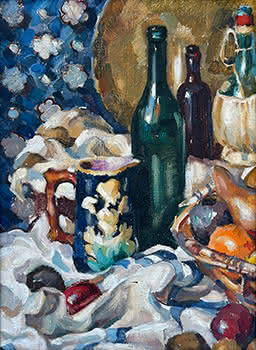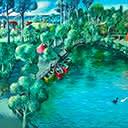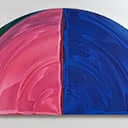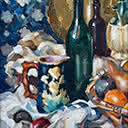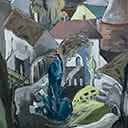Still Life with Green Bottle, c. 1970
57.5 x 42 cm
PROVENANCE
Private Collection, Auckland
Webb's, Important New Zealand Paintings,
Auckland, 10/11/1994
Collection of the artist's daughter, Christchurch
Over the course of her career, Evelyn Page painted many portraits tender, inquisitive portrayals of family members, friends and contemporaries. Many of these works are noted for their directness and freedom of painted expression.
Born in 1899, Evelyn Margaret Polson was the youngest of seven children. Her parents John and Elizabeth Polson were straight laced, "Victorian" as Evelyn described them. Although this was a strictly religious upbringing she was encouraged to foster a love of music, art and writing from a young age. In 1915, fifteen year old Evelyn joined the Canterbury College School of Arts where her formal training began and she would remain until 1922. She quickly proved herself to be a talented student, receiving numerous accolades and prizes. This was of course a formative time for the young artist, who in addition to learning from teachers Margaret Stoddart, Leonard Booth and Cecil Kelly, forged a number of lifelong friendships and connections with her peers including Ngaio Marsh and Viola Macmillan Brown.
She became a member of the Canterbury Society of Arts in 1922. For a period after this Page focused on music, studying piano with Ernest Empson. Awareness of this musical talent deepens an appreciation of her paintings which have a musical sensitivity to them. Page's affinity for finding rhythm in composition and colour gives many of her works a deep visual musicality. It was through Empson that she met Frederick Page. During 1936 her first solo exhibition was held at the Durham Street Gallery, Canterbury Society of Arts. The exhibition was a great success with every work selling at the opening. Evelyn was one of the founding members of the New Zealand Society of Artists and taught part-time at Christchurch Girls' School before joining Frederick in London in 1937. The period that followed was one of exceptional and prolific creative output for her. During this period the couple built their network of friends and fellow artists in London and travelled around Europe.
Upon their return to New Zealand, Frederick and Evelyn married and settled in Governors Bay where they lived for several years. They had two children, Sebastian and Anna. Whilst living there, and over the course of a number of summer painting holidays (a tradition she maintained throughout her life), Evelyn mastered the pure treatment of colour in her work. After Frederick was appointed to set up the School of Music at Victoria University in 1945, the family moved to Wellington. Evelyn and the children lived in Pukerua Bay she used to travel into the city to visit Frederick and to paint. Page's wonderfully expressive portraits of friends and peers, interior still lifes and cityscapes now stand out as a form of protest in response to mainstream modernism.
The Pages returned to London and Evelyn attended a summer school in Salzburg. In the 1960s and 1970s Page's work assumed a quieter, more interior focus. Living in Waikanae and suffering from arthritis, a slower rhythm sustained her in the final decades of her work. She died in 1988. Page was a visionary, and her works possess a refreshing vivacity of spirit which have stood the test of time.

